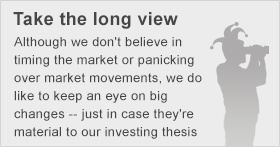
Let's look at four stocks -- Tesaro (NASDAQ: TSRO), Alnylam Pharmaceuticals (ALNY 0.03%), Allergan (NYSE: AGN), and Valeant Pharmaceuticals (VRX +0.35%) -- that could all loom large in health-care headlines this Monday morning.
Tesaro reports positive phase 3 results for rolapitant
Tesaro just announced positive phase 3 results for rolapitant, its investigational treatment for chemotherapy-induced nausea and vomiting, or CINV. CINV affects roughly 70% of patients who undergo chemotherapy. Shares of Tesaro are up more than 7% in pre-market trading this morning.
Tesaro said the trial met its primary endpoint of achieving a complete response in the delayed phase (24 to 120 hours) of CINV. It also achieved its key secondary endpoints of achieving complete responses in the acute (0 to 24 hour) and overall (0 to 120 hour) phases of CINV. No significant nausea was reported, and the adverse event profile was consistent with earlier clinical trials.
Tesaro said it was on track to submit a new drug application for rolapitant to the FDA by mid-2014. Rolapitant is in phase 3 trials for its oral indication and phase 2 trials for its intravenous indication. If rolapitant is approved, analysts at BMO Capital expect the drug to generate peak sales of $336 million -- not a blockbuster by any means, but still a solid source of revenue for Tesaro, which has no marketed products.
The biggest challenge for Tesaro, however, is convincing the market that rolapitant offers any clear advantages over Merck's Emend, a similar drug that prevents CINV for up to five days after chemotherapy is administered. Both rolapitant and Emend are NK-1 receptor antagonists that block a substance in the brain that causes vomiting. Sales of Emend rose 3.7% year over year to $507 million in fiscal 2013.
Alnylam adds a new treatment for hepatitis B to its pipeline
Meanwhile, Alnylam just added a new treatment to its pipeline: ALN-HBV, for the treatment of hepatitis B. The new program comes from Alnylam's acquisition in January of Merck's RNAi assets, which included the company's Sirna Therapeutics subsidiary.
Alnylam will work toward filing an investigational new drug application for the drug by the end of fiscal 2015. New data regarding the drug will be presented at the TIDES 2014 meeting from May 12-15 in Providence, R.I. Although potential approval for the drug is years away, shares of Alnylam have jumped more than 10% in pre-market trading in response to the development.
Alnylam's other pipeline products all center around RNAi therapeutics. The company's most advanced pipeline products are ALN-TTR02 and ALN-TTRsc, which are in clinical trials for treating TTR-Mediated Amyloidosis. ALN-TTR02 is in phase 3 trials, while ALN-TTRsc (subcutaneous version) is in phase 2 trials.
Alnylam holds strategic alliances with several major pharmaceutical companies, including Sanofi, Merck, Monsanto, and Medtronic. Shares of Alnylam have climbed more than 110% over the past 12 months.
Allergan officially rejects Valeant's takeover bid
Last but not least, Allergan's board just officially rejected a takeover bid from Valeant Pharmaceuticals, stating that the unsolicited $46 billion offer undervalued the company and carried significant risk. The Valeant effort, spearheaded by activist investor Bill Ackman, prompted Allergan to adopt a poison pill plan last month to guard against a hostile takeover.
Valeant's proposed offer would have exchanged each share of Allergan for $48.30 in cash and a portion of shares of Valeant. Allergan stockholders would have owned 43% of the combined company. However, Allergan stated that Valeant's uncertain long-term growth prospects would pose a risk for both companies.
Allergan is best known as the maker of Botox. Allergan expects to generate $2.18 billion to $2.28 billion in Botox sales in fiscal 2014, which would account for nearly a third of its full-year product sales forecast of $6.78 billion to $7 billion. Valeant, which acquired Botox's rival treatment Dysport through its $2.6 billion acquisition of Medicis Pharmaceutical in December 2012, is Allergan's top competitor in the cosmetic drug market.
The combined company, which would have also merged Allergan's plastic surgery supplies with Valeant's growing portfolio of dermatological products, would have become the undisputed market leader in cosmetic drugs.







